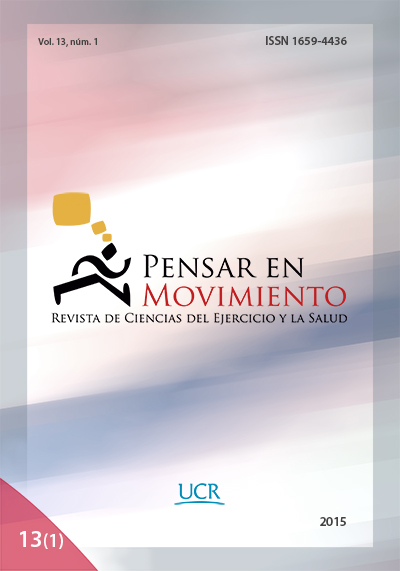Resumo
Supõe-se que um antitranspirante efetivo é capaz de diminuir o suor até 50% como afirmam as companhias que fabricam isto produtos, mas são poucas evidências a respeito do mesmo: é possível que a real diminuição seja pequena não podendo ser detectada com métodos convencionais. O objetivo deste estudo foi verificar se o método de adesivos de suor é capaz de detectar a diminuição da taxa de transpiração localizada que deve ocorrer a través da utilização de um antitranspirante. Alem disso, a magnitude do efeito foi medido. Verificou-se a influencia que tem o antitranspirante (Condição A, pele rociada com antitranspirante) na taça de sudoração localizada da zona escapular durante 20 minutos de exercícios na intensidade entre 78% e 80% da FCmax com temperatura ambiental media de 29.7 ± 0.5°C e humidade relativa de 54 ± 3.4%, comparado com uma condição controle (C) (pele sim antitranspirante). Controlaram-se diferenças estatisticamente significativas entre as condições A = 14.6 ± 10.3 μL * min-1 y C = 19.2 ± 12.6 μL * min-1 (p = 0.001) na taça de sudoração da zona escapular, ou seja, que os participantes suaram aproximadamente 24% menos quando se aplico antitranspirante comparado com a pele intata, de acordo com as medições obtidas com as adisivos de suor.Referências
Adams, R. (1999). Revised physical activity readiness questionnaire. Canadian Family Physician, 45, 992. 995, 1004-1005. Extraído de la página web: http://www.ncbi.nlm.nih.gov/pmc/articles/PMC2328306/
Bain, A., Deren, T., & Jay, O. (2011). Describing individual variation in local sweating during exercise in a temperate environment. European Journal of Applied Physiology, 111(8), 1599-1607. Doi:10.1007/s00421-010-1788-9. Extraído de la página web: http://www.ncbi.nlm.nih.gov/pubmed/21190033
Burry, J., Evans, R., Rawlings, A., & Shiu, J. (2003). Effect of antiperspirants on whole body sweat rate and thermoregulation. International Journal of Cosmetic Science, 25(4), 189-192. Extraído de: http://www.ncbi.nlm.nih.gov/pubmed/18494900
Burton, A. C. (1934). A new technic for the measurement of average skin temperature over surfaces of the body and the changes of skin temperature during exercise. The Journal of Nutrition, 7(5), 481-496. Extraído de la página web: http://jn.nutrition.org/content/7/5/481.short
Gellis, R., Goslin, B., Olson, R., McDonald, A., Russi, G., & Moudgil, V. (2007). Longitudinal modeling on the relationship between age and maximal heart rate. Medicine and Science in Sport and Exercise, 39(5), 822-829. Doi:10.1097/mss.0b013e31803349c6 Extraído de la página web: http://europepmc.org/abstract/med/17468581
Havenith, G., Fogarty, A., Bartlett, R., Smith, C., & Venttenat, V. (2008). Male and female upper body sweat distribution during running measured with technical absorbents. European Journal of Applied Physiology, 104(2), 245-255. Doi: 10.1007/s00421-007-0636-z. Extraído de: http://link.springer.com/article/10.1007%2Fs00421-007-0636-z
Marfell-Jones, M., Olds, T., Stewart, A., & Carter, L. (2006). International standards for anthropometric assessment / Normas internacionales para la evaluación antropométrica. ISAK: Potchefstroom, South Africa. Extraído de la página web http://www.isakonline.com/publications
Maughan, R., Merson, S., Broad, N., & Shirreffs, S. (2004). Fluid and electrolyte intake and loss in elite soccer players during training. International Journal of Sport Nutrition and Exercise Metabolism, 14(3), 333-346. Extraído de la página web: http://www.coachingireland.com/files/fluid.pdf
Oppliger, R., & Bartok, C. (2002). Hydration Testing of Athletes. Sports Medicine, 32(15), 959-971. Extraído de la página web: http://www.ncbi.nlm.nih.gov/pubmed/12457417
Phillips, M., & McAllon, M. (2008). A sweat-patch test for alcohol consumption: Evaluation in continuous and episodic drinkers. Alcoholism Clinical & Experimental Research, 4(4), 391-395. Extraído de la página web:
http://www.ncbi.nlm.nih.gov/pubmed/7004238
Reynolds, K., Darrigrand, A., Roberts, D., Knapik, J., Pollard, J., Duplantis, K., & Jones, B. (1995). Effects of antiperspirant with emollients on foot-sweat accumulation and blister formation while walking in the heat. Journal of the American Academy of Dermatology, 33(4), 626-630. Doi: 10.1016/0190-9622(95)91283-5. Extraído de la página web:
http://www.jaad.org/article/0190-9622(95)91283-5/abstract
Schmidt-Rose, T., Lehmbeck, F., Bürger, A., Windisch, B., Keyhani, R., & Max, H. (2013). Efficient sweat reduction of three different antiperspirant application forms during stress-induced sweating. International Journal of Cosmetic Science, 35, 622-631. Extraído de la página web: http://www.ncbi.nlm.nih.gov/pubmed/23906286
Shirreffs, S., Aragón-Vargas, L., Chamorro, M., Maughan, R., Serratosa, L., & Zachwieja, J. (2005). The Sweating Response of Elite Professional Soccer Players to Training in the Heat. International Journal of Sports Medicine, 26(2), 90-95. Extraído de: http://www.researchgate.net/publication/8008087_The_sweat
ing_response_of_elite_professional_soccer_players_to_training
_in_the_heat
Smith, C., & Havenith, G. (2011). Body mapping of sweating patterns in male athletes in mild exercise-induced hyperthermia. European Journal of Applied Physiology, 111(7), 1391-1404. Extraído de: http://www.medscape.com/viewarticle/775404







